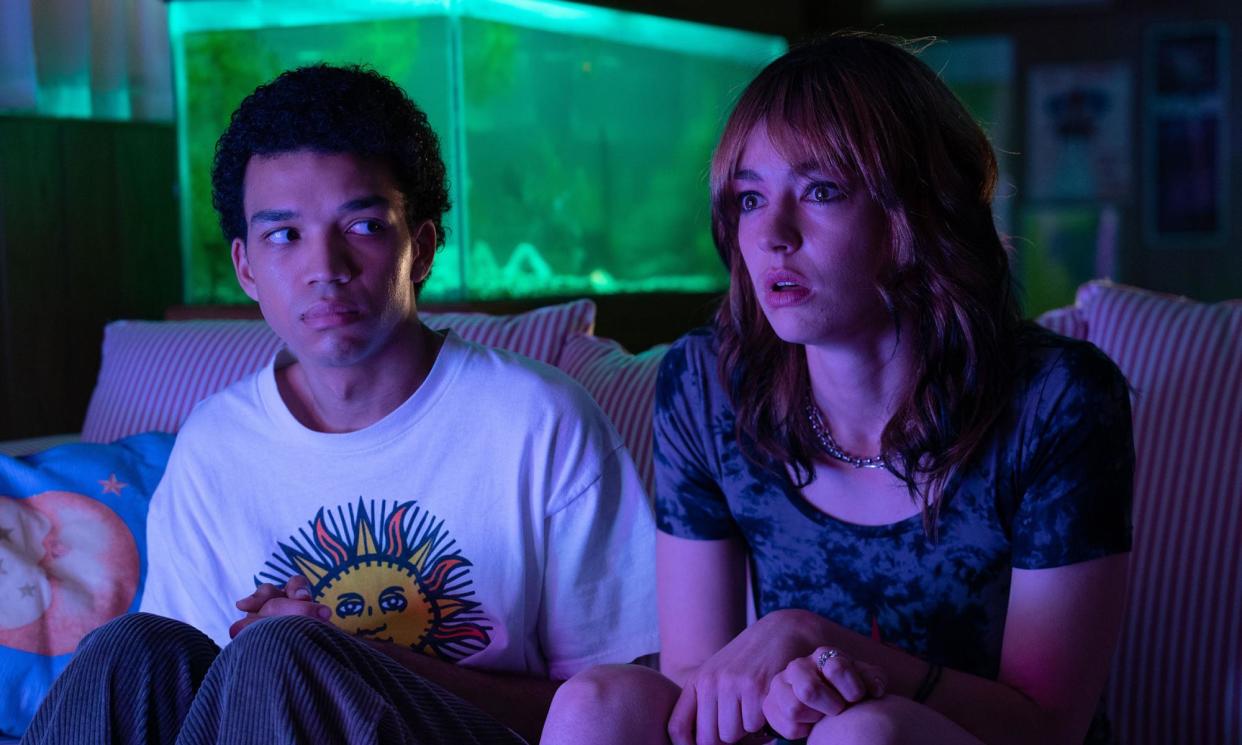I Saw the TV Glow review – devastating tale of identity, fandom and obsession

The post-Get Out influx of “elevated” horror films, more focused on the construction of a smug metaphor than coherence or cohesion, has become a blight on an already blighted genre. It’s an incredibly difficult web to weave - even Jordan Peele himself facing the odd stumble since his ground-shifting breakout – yet still so many keep trying, dissertations clumsily disguised as films.
But in I Saw the TV Glow, a buzzy, brilliant new film premiering at the Sundance film festival, the writer-director Jane Schoenbrun has made it all look so easy, crafting something loaded with meaning yet light on its feet, provoking us to discussion and debate while never feeling like an academic exercise – a movie that never forgets that it’s, well, a movie.
Related: The Outrun review – Saoirse Ronan is remarkable in a sensitive recovery drama
What makes their film doubly remarkable is that it’s also about relatively recent nostalgia, another tiresome pitfall for many as small and big screens are consumed by pop culture references thrown at us without thought or care, offering recognition for recognition’s sake. I Saw the TV Glow, mostly set in the 90s and early 00s, is far sharper than that. Schoenbrun avoids the mistakes others have made by audaciously creating their own, utterly believable media landscape (original songs from Phoebe Bridgers and Caroline Polachek feel perfectly of the time without being pastiche-y) while realising that nostalgia can be a corrosive force. Their film isn’t a simple indictment of fandom – Schoenbrun is aware of how overwhelming and affirming it can feel to truly love a piece of culture – but it’s also aware of the problems such obsession can bring, when it goes from being your something to being your everything.
We first see glimpse this something on the TV set of 12-year-old Owen (excellently played by Let the Right One In’s Ian Foreman). He sees a commercial for a teen fantasy show called The Pink Opaque and is transfixed by the Buffy-esque monster-of-the-week horror that’s just out of his reach (it airs past his bedtime on Saturday nights). When he encounters the ninth-grader Maddy (Atypical’s Brigette Lundy-Paine) reading an episode guide for the show, the two begin a tentative, awkward friendship, Owen lying about sleepovers with another friend in order to watch episodes with Maddy. As the years go on, a slightly older Owen (played from 14 upwards by Justice Smith, a big ask that pays off) and Maddy barely speak, their communication limited to recorded episodes left on videotapes. Both are uncomfortable with a life lived outside of the small screen universe they have become consumed with. When the show is cancelled, things start to fracture, and years later, when the pair see each other as twentysomethings, they start to question the nature of their reality.
I wasn’t always convinced by Schoenbrun’s lauded debut, the lo-fi internet body horror We’re All Going to the World’s Fair – an intriguing if incomplete mood piece – but I was impressed by their ability to conjure a moment of deep-in-your-stomach creepiness, understated yet often overwhelming, the kind that sticks with you for longer than you might like. I Saw the TV Glow marks a remarkable progression for Schoenbrun as both writer and director, a more substantive, if still challenging, narrative married with an incredible, expanded ability to fully immerse us in the visuals they have created. It’s made with such transportive precision that I can still feel it as I write – an atmosphere so intoxicating, it feels less like the creation of a movie and more of an entire world, a scary and sad place more familiar to some of us than to others.
Our ability to escape into a fictional construct becomes harder with age, not just because of how we change and close down as people but because of shifts in how we consume entertainment. Schoenbrun understands the thrill and reward of the journey we used to take with physical media, the hurdles we had to face and how much investment we had in what we could amass. There’s a poignant little scene when Owen, as an adult, finds that his once prized show is now easily available to stream, all there with a click, but it looks different, feels different, and suddenly he’s embarrassed: did I dream this? Was any of it real?
What the film is ultimately about, the uncomfortable places it ends up taking us, will likely be pored over with the same kind of rabid obsessiveness that the characters have for their favourite show. It’s about loneliness and fandom and maybe what it’s like to deal with mental illness or be close to someone with that struggle, to see someone losing their grip and the pain that brings. But it’s also a story about what it’s like to be queer or trans, Schoenbrun using both characters to show the devastation of a life unlived in a way that recalls the more unsettling elements of Andrew Haigh’s heart-crushing drama All of Us Strangers. Schoenbrun, a nonbinary and trans artist, has found a way to cleverly and subtly involve us in an experience often flattened or made digestible for the masses. The last act is an imperfect folly, pushing us a little too far in places, but when we’re pulled back, it’s with an almighty gut-punch, a howl of sadness that’s still ringing in my ears. I Saw the TV Glow is a puzzle with pieces missing and like many who soon experience it, I’ll be haunted trying to find them.
I Saw the TV Glow is screening at the Sundance film festival and will be released later this year

 Yahoo Movies
Yahoo Movies 
